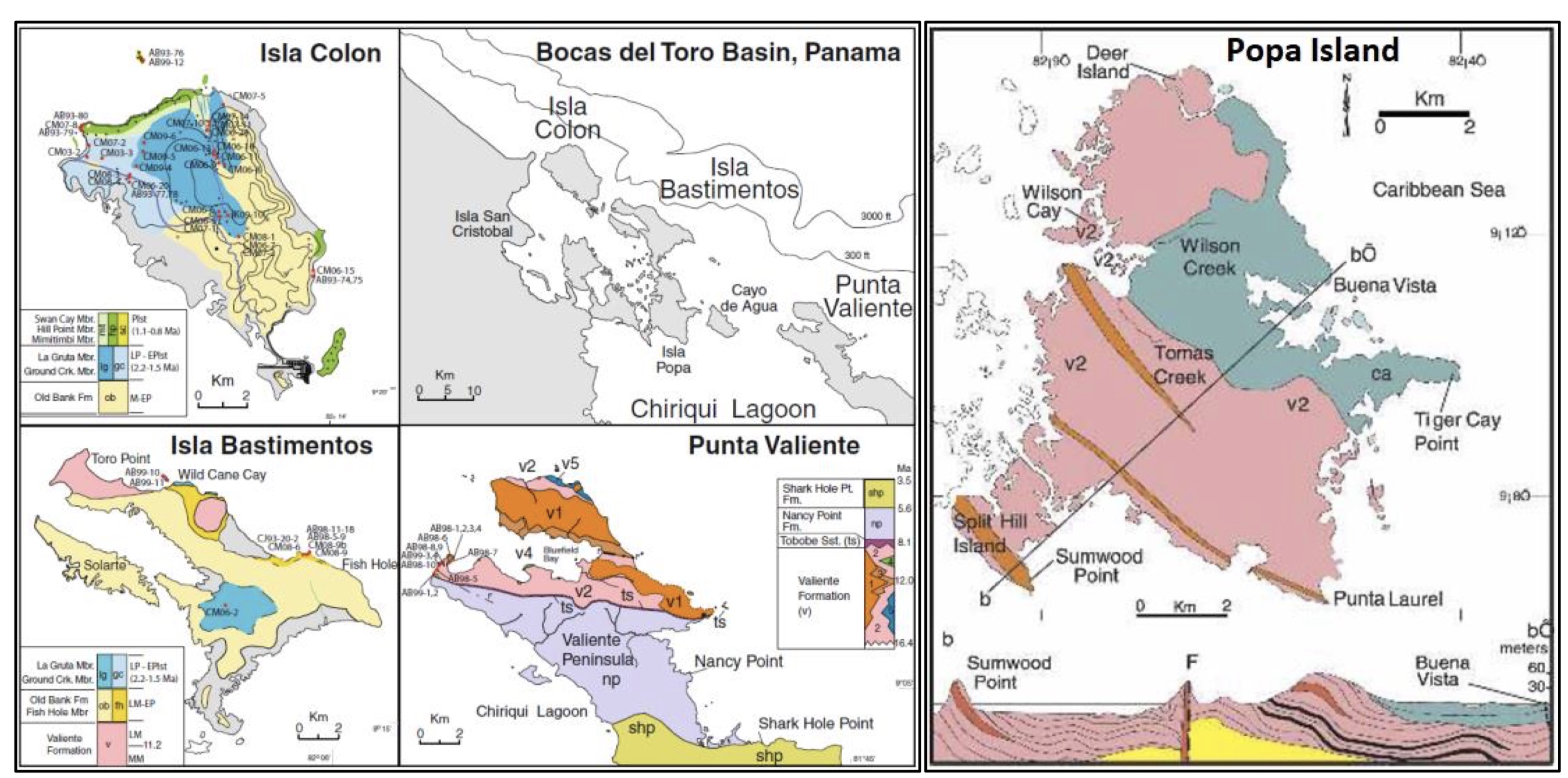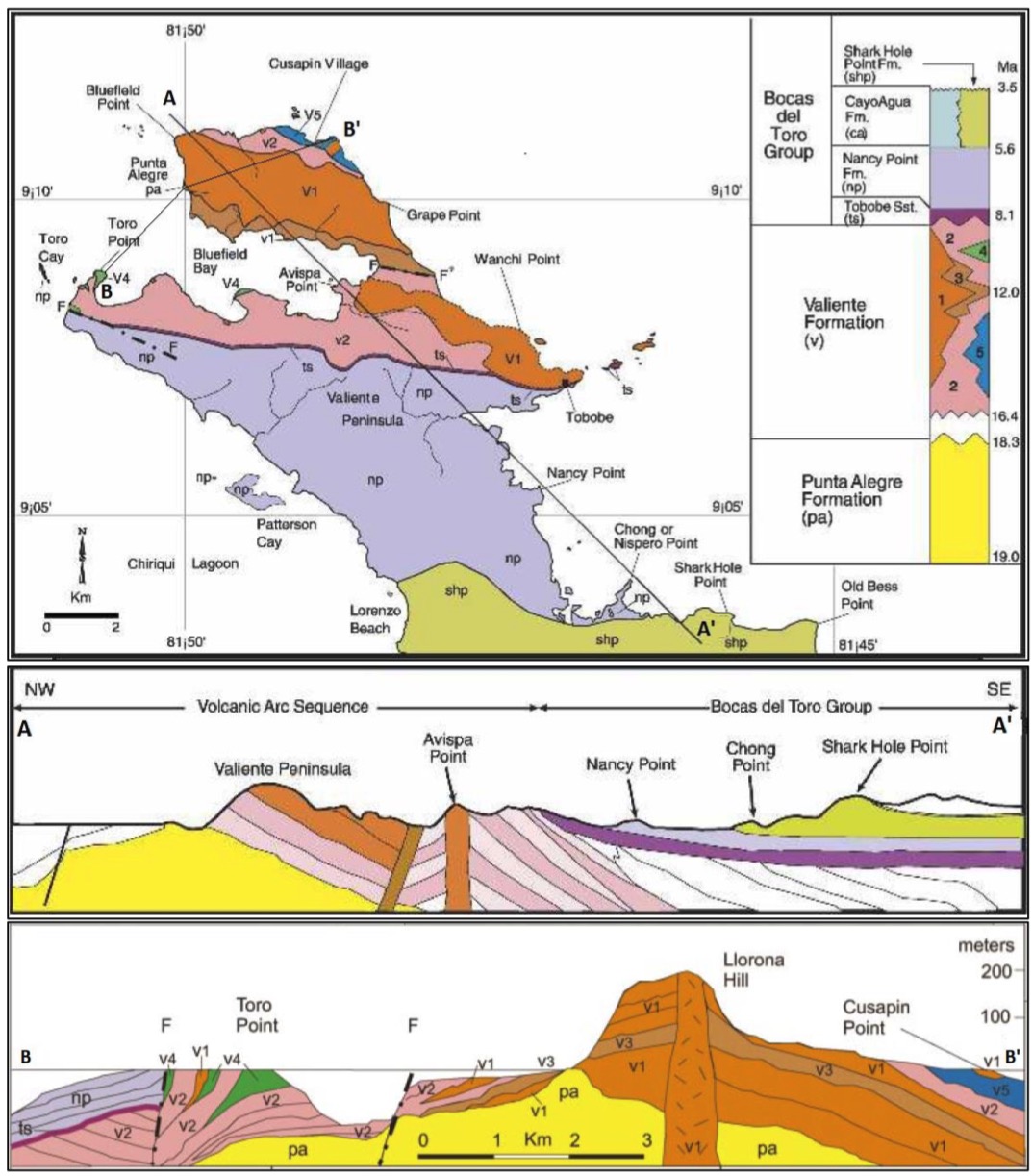Bocas Del Toro Gr
Type Locality and Naming
Olsson (1942b). Name “Bocas Fm” appears on chart for sediments on Bocas Island [Isla Colon]. The most continuous section lies along the east and west coasts of the Valiente Peninsula (Fig.1) where it ranges from late Miocene (Messinian, 7.2-5.3 Ma) to late Pliocene (∼3.5 Ma) by Coates (1999).
[Figure 1. Bocas del Toro archipelago, NW Panama with map of the western & central portion together with the geological maps of Isla Colon, Isla Bastimentos, Punta Valiente (Klaus et al. (2012)) and Popa Island (Coates et al. (2005)). Section (b-b’) over Popa Island shows the Valiente Fm where it is unconformably overlain by the Pliocene Cayo Agua Fm. On Popa Island, only the v1 basalt flow facies and the v2 coarse volcaniclastic facies (see Figure 043) (not associated with reef lenses) are present, with thin layers of low rank coal, an example of which is exposed along the coast immediately north of Punta Laurel. A prominent basalt dike is exposed at the tip of the Punta Laurel where it cuts the Valiente Fm.]
Synonym:
Lithology and Thickness
The Caribbean Bocas Del Toro Gr lies non-conformably on the underlying volcanics of the Valiente Fm. It has about 1000 m of sediments, ranging from 8.5 to about 1.5 Ma. Extinction, cooling, and subsidence of the volcanic arc locally in the region of the Bocas del Toro archipelago engendered a marine transgression represented by the Bocas Del Toro Gr. Coates (1999) (Fig. 043 (Valiente Peninsula)).
See individual formations (mentioned below) within the Group:
Coates et al. (1992) sub-divide the Bocas Del Toro Gr (Fig. 2) as seen below from oldest (bottom) to youngest (top), however subsequent authors brought some minor changes to it (as indicated):
- Swan Cay Fm (now part of the Urraca Fm; Klaus et al. (2012))
- Isla Colon Fm (Klaus et al. (2012))
- Escudo De Veraguas Fm. A shallowing upward sequence, culminating in extensive, shallow marine, mixed volcaniclastic and coral reef deposits, about 2 Ma, many of which are exposed in unnamed units on Bastimentos and Colon islands. (Fig. 1)
- Cayo Agua Fm / Shark Hole Point Fm. A shallowing upward sequence.
- Nancy Point Fm. Upper bathyal facies (Collins (1993))
- Tobabe Fm. Transgressive, near-shore marine facies (7.26-5.32 Ma).
[Figure 2. Coates et al. (2003 & 2005)’s description of the geological map and cross sections (A-A’ and B-B’) of the Valiente Peninsula (Punta Valiente) showing the distribution of the Punta Alegre Fm and Valiente Fm and the Bocas Del Toro Gr. The five lithofacies of the Valiente Fm are indicated by separate colors and numbers on the key (upper right) as follows; v1) basalt lava and flow breccia facies; v2) coarse volcaniclastic facies; v3) pyroclastic facies; v4) coral reef facies; v5) marine debris flow and turbidite facies.]
Relationships and Distribution
Lower contact
Upper contact
Regional extent
GeoJSON
Fossils
Age
Depositional setting
Additional Information
References:
- Olsson (1942b)
- Woodring (1960). “Bocas Fm” is an undefined name for strata of Pliocene age
- Jung (1989);
- Coates et al. (1992); Renamed “Bocas Fm” as “Bocas Del Toro Gr” and subdivided it as seen below (with some adjustments from subsequent authors).
- Collins (1993); Cairns (1995); Collins et al (1999); Coates (1999); Budd et al. (1999); Collins et al. (1999a & 1999b); Coates et al. (2003 & 2005) ; Beu (2010); Kiessling et al. (2011); Klaus et al. (2012); Landau et al. (2012b); Jaramillo et al. (2014);

